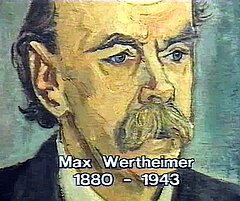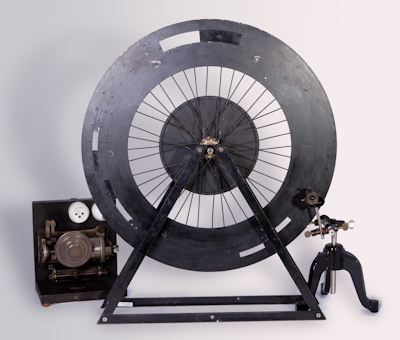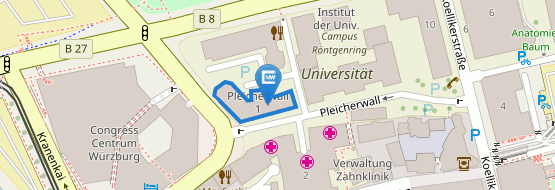Max Wertheimer Tachistoscope
Motions that moved the Gestalt psychology
On January 29, 1912 Max Wertheimer (1880-1943) submitted his postdoctoral thesis (Habilitation), titled "Experimentelle Studien über das Sehen von Bewegung” (Experimental studies about the perception of movement), for publication in the magazine "Journal of Psychology" published by Friedrich Schumann. The paper had already been published in the first issue of the year and dealt with the intense examination of slider-, stroboscopic, and tachistoscopic induced movement impressions of an identical stimulus. One and the same stimulus was presented in real movements as well as in successive presentations as a non-moving stimulus leading to an indistinguishable apparent movement.
Wertheimer draw a special attention to the three distinguished stages of succession, optimal movement, and simultaneity. How, he was wondering, could one obtain a perfect impression of motion? How does it emerge from simultaneous or successive stages and their transitions? Due to his measurements, Wertheimer was able to identify an interval of approximately 56ms necessary to perceive a movement between the two stimuli. A shorter interval of 30ms results in perceiving both stimuli simultaneously, while longer intervals of 180ms cause a latent, non-moving perception. Moreover, Wertheimer came to the conclusion that the sensation of motion is not tied to the identity of the stimulus. The transition among the "distinguished stages" in particular could also cause partial or singular movements. In addition, the focus of attention does also have a legitimate impact on what one sees. When the focus is on the gap between the objects, the sensation of motion is heightened. Finally Wertheimer stated that the apparent movement caused by successive presentation is "equal in strength, perhaps greater" (Wertheimer, 1912, p. 235) than the sensation of an actually moving object.
Wertheimer's main experiments were conducted at the Department of Psychology at the University of Frankfurt a. M. in the fall and winter of 1910, using a Schumann's Tachistoscope, making the successive exposure of two stimuli under equal conditions possible. At the same time, Friedrich Schumann got in charge of the Department in Frankfurt, after Karl Marbe had obtained a chair at the University of Würzburg. Therefore, Wertheimer was able to work with the Tachistoscope under quite good conditions. Schumann publicly demonstrated his Wheel-tachistoscope on December 15, 1899 first at the Psychological Association in Berlin (Flatau and Giering, 1899). Further showings of the device took place at conferences for experimental psychology in Gießen, 1904 and Würzburg, 1906. It is interesting to know that Schumann already discussed the by the Tachistoscope caused apparent motion of a vertical and horizontal bar - resulting in a cross in an overall picture - at the conference in Würzburg. He came to the conclusion that the sensation of motion must be "a content of consciousness, centrally generated and in addition to all perceptual images, regardless of whether you would like to describe it as Exner's perception of movement or as Ehrenfels' Gestalt quality."
(Armin Stock)
Literatur:
Flatau, Th.S. & Giering, H. (1899). Psychologischer Verein zu Berlin. Sitzungsberichte. Zeitschrift für Pädagogische Psychologie, I, 95-100.
Schumann, F. (1907). Psychologie des Lesens. In: Friedrich Schumann (Hrsg.). Bericht über den 2. Kongress für experimentelle Psychologie in Würzburg vom 18. bis 21. April 1906. Leipzig: Johann Ambrosius Barth.
Wertheimer, M. (1912). Experimentelle Studien über das Sehen von Bewegung. Zeitschrift für Psychologie, 61, 161-265.




